26 April 2024Meeting Tuesday 21st May 2024
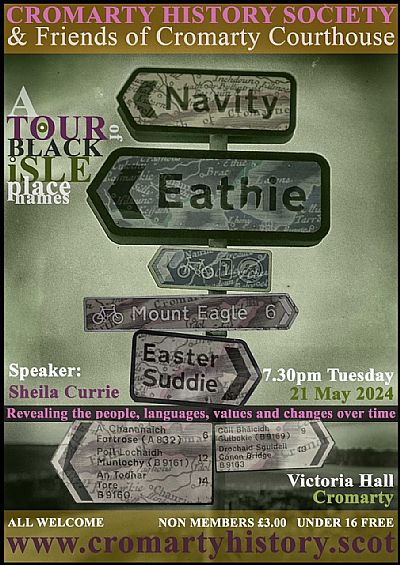
A Tour of Black Isle Place Names — Revealing the people, languages, values and changes over time
Sheila Currie
Victoria Hall, Cromarty
As we go about the Black Isle, do we ever wonder where our place-names come from and what they mean? This talk will take the form of a tour around the Black Isle, stopping to peer at some of the roadsigns we pass by without a thought; teasing out what these place‐names can tell us about the histories of the people who have lived here since these names were first written down. What do the names we give tell us about what was important to the people at that time? Which languages did they speak and how did the languages change? How did that change the placenames over time? Hopefully, you will come away with a flavour of the deep history of the places we whizz past in our car or vaguely notice out the bus window and may be inspired to do your own examining of the many hundreds of local placenames that I won't be able to mention in this talk.
After spells working in Archaeology, Geology, various factories, the Oil Industry, Nature Conservation and Environmental Management, being retired allowed Sheila to follow her nose and be entranced by what’s around her, including (very) amateur history research into this part of the world, where she has lived for 32 years now. She is fascinated by the people who have lived hereabouts since the glaciers receded some 12,000 years ago and what is revealed by the traces they have left.
Cromarty History Society now meets on the third Tuesday of each month, September‐April and occasionally during the summer
25 April 2024Annual Report 2023-24
CHS Annual Report for 2023‐24
We’ve endeavoured to present a varied programme of talks again this year. To summarise
- We’ve heard about some archaeology at the west end of the Black Isle, around Tarradale and Muir of Ord
- We were introduced to the life and travels of a 17C Scottish Episcopalian minister (James Fraser from Kirkhill) and the legacy he left through his writings, which gave a slightly different viewpoint of the Highlands at that time
- We were told about map-making in 17thC — in particular how maps became an essential part of running an estate. There was even some hands‐on experience with a specialist tool used to produce these accurate and informative maps
- We delved into some local family history, with a tale of two shopkeepers ‐ a father and son, who exerted their influence on this town
- We were invited to reflect on another side of Macbeth, Thane of Cromarty ‐ his local associations and how he has been unfairly portrayed in folklore and history
- We were entertained to an amusing talk about milestones that ran into many other topics …
There are 2 further lectures we are looking forward to — tonight’s on sources for information on Cromarty and the locality in some of the larger archives and next month — to our postponed talk on Black Isle place names.
As a Friends Group of the Courthouse, we aim to help the museum financially, or give assistance in kind. Last July, we arranged for local Tain author, Philip Paris, to deliver a talk about the witchcraft trials in Scotland. Entry was by donation and the event attracted a large audience; as a result we were able to raise funds of £300 for the museum. Earlier this month we hosted, together with the Courthouse, another talk, this time by Kate Forbes (our local MSP) on emigration from Isle of Lewis to French speaking Canada. This raised a further £150. To conclude my report, you are all aware that we have an exodus of committee members at this AGM. These are all people who have given time and enthusiasm to keep the society running successfully for a long time and particularly to survive those “pandemic years”. In fact together they’ve totalled up nearly 50 years’ service as committee members.
I’m referring to:
- Gillian Jones — joined committee in 2011, she has been our very competent secretary for nearly all that time and is always busy on the refreshment front
- Paul Monk — joined in 2012 as the Courthouse representative and has shared his knowledge of various historical subjects in talks to society and also in answering queries coming through our website
- Brenda Monk — joined in 2016 to become our treasurer, she has been keeping track of our finances and communicating with members since then
- Sheila Currie — joined in 2016 bringing both enthusiasm and ideas and has also shared some of her research in talks to the society
- Gordon Haynes — joined in 2018 and has acted as our diligent programme secretary for the last 5 years and delivered talks to us referencing town planning
I want to thank you all sincerely, for your longstanding commitment to the society and in particular for the support you have given me as convenor during that time. It’s also a farewell to the artistic talents of John McNaught, who has provided us with such brilliant posters every month since September 2011. We have an archive of all these posters for posterity! Gillian, please pass our heartfelt thanks to John — and tell him he’s been a real star. Thanks also to Roger Young, who keeps our website up‐to‐date (since 2015) with news and reports and happily will continue to do this for us. I don’t want to miss out mentioning Ross Couper, who joined the committee at the same time as Gillian in 2011 and has taken sole responsibility for getting the tech we have used, both in the East Church Hall and now the Victoria Hall, ready and functioning for our meetings. He also exerts his energy every meeting putting out all the chairs. Ross is happy to continue in these roles. Refreshments and the social time at the end of our meetings is a key to success, so again that’s due to the efforts of the committee! Finally thank you, our audience, for continuing to show your support through attending our meetings.
Mary Bowers
April 2024
05 April 2024Meeting Tuesday 16th April
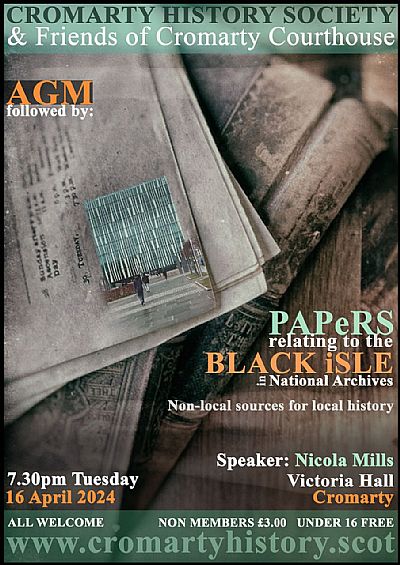
Tuesday 16th April 2024: AGM followed by Papers Relating to the Black Isle in National Archives — Non-local sources for local history
Dr. Nicola Mills
Victoria Hall, Cromarty
Births, deaths and marriages, property records, wills, census, military service — most historians will know where to find these in national archives. But what about the little bits and pieces, the details of a place, the chance encounters? This talk, whilst not comprehensive, aims to tease out a few interesting sources for information on Cromarty in some of our larger archives across Scotland and perhaps beyond.
Nicola Mills graduated with a PhD from St. Andrews University before going on to train as an archivist in London. She worked at the School of Oriental and African Studies, the Scottish United Services Museum (now the National War Museum of Scotland) in Edinburgh Castle and the Scottish Record Office (now the National Records of Scotland) before becoming freelance. Since then she has specialised in estate archives and military, medical and distillery records, working for Aberdeen City and Shire archives, Aberdeen University, and the Scottish Episcopal Church amongst others. She also teaches the Latin modules on the Dundee University archive course.
Cromarty History Society now meets on the third Tuesday of each month, September‐April and occasionally during the summer
26 March 2024Meeting Thursday 4th April
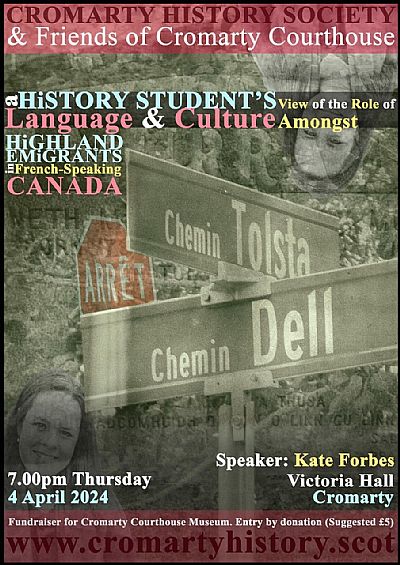
Thursday 4th April 2024: A History Student’s View — of the Role of Language and Culture Amongst Highland Emigrants in French‐Speaking Canada
Kate Forbes
Victoria Hall, Cromarty
In the 1800s, thousands of islanders, mostly from the Isle of Lewis, were supported and encouraged to emigrate to the Eastern Townships of Quebec. During the famine years, despite James Matheson (who has links to Cromarty) actively finding work for impoverished and hungry islanders, many chose to emigrate. They arrived in the Eastern Townships of Quebec, which still bear the place names of Lewis. Now it is a francophone area, raising fascinating questions about the retention of language and culture amongst the migrant community.
Kate Forbes has been the Member of the Scottish Parliament for the Skye, Lochaber and Badenoch constituency since 2016. Kate is from Dingwall in the Scottish Highlands, although she spent part of her upbringing in Glasgow and India. Until she was elected as MSP for Skye, Lochaber and Badenoch, Kate was employed as an accountant in the banking industry. Prior to that she studied History at the Universities of Cambridge and Edinburgh. In 2018 she was appointed as Minister for Public Finance and Digital Economy and was promoted to Cabinet Secretary for Finance in February 2020, a position she held for three years. She ran for the SNP leadership last year, but despite securing 48 per cent of the vote, lost out narrowly to Humza Yousaf. Kate currently sits on the Parliament’s Rural Affairs and Islands and Constitution, Europe, External Affairs and Culture Committees and is a columnist for The National newspaper. This talk is offered as that of an historian, not a politician.
Cromarty History Society normally meets on the third Tuesday of each month, September‐April and occasionally during the summer. This talk is supplementary to the season’s programme.
05 March 2024Meeting Tuesday 19th March 2024
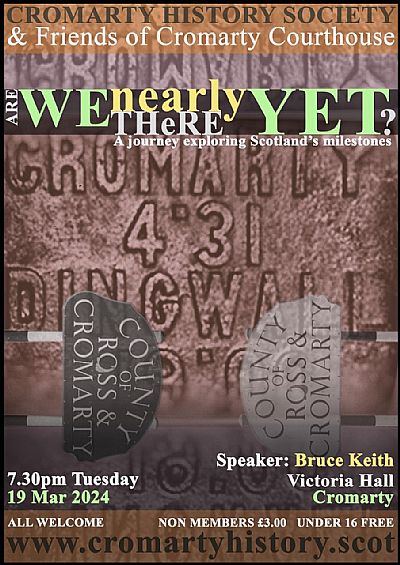
Are We Nearly There Yet? — A journey exploring Scotland’s milestones
Bruce Keith
Victoria Hall, Cromarty
This talk covers not just distances markers, but early methods of measurement and mapping and the travellers of the 18th and 19th centuries whose journals laid the foundation of the Scottish tourist industry. It also celebrates the ‘Top 50 Scots’, the sportsmen and women who have gone the extra mile in terms of speed and endurance to set new world records — so there’s something for everyone.
Bruce Keith has become an ambassador for the sustainable use of water resources globally. Last year as President of the Chartered Institution of Water and Environmental Management (CIWEM), he travelled extensively from New Zealand to Finland via Africa.
This has left little time for golf, which is evidenced by his handicap. Bruce is a retired chartered surveyor and environmentalist. He spent his formative years in Inverness‐shire and his early career on several Perthshire and Aberdeenshire estates. He was with the Department of Agriculture in Edinburgh before migrating south of the border to become Chief Surveyor with English Nature. Bruce retired as Head of Property at SSE (the Hydro Board) nine years ago, since when he has written “Bridgescapes” on Scotland’s bridge building heritage, followed by “Are We Nearly There Yet?” — about Scottish Milestones. Not just distance markers but much else besides, he assures me, and it is on that journey that Bruce takes us this evening.
Cromarty History Society now meets on the third Tuesday of each month, September‐April and occasionally during the summer
04 February 2024Meeting Tuesday 20th February 2024
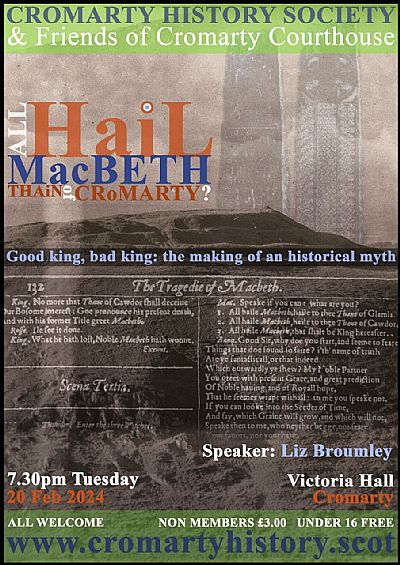
All Hail Macbeth, Thain of Cromarty? — Good king, bad king: the making of an historical myth
Liz Broumley
Victoria Hall, Cromarty
Of Macbeth, did one of the weird sisters actually say “Lo, yondyr the thayne of Crwmbarthy”? Was this a king under whose reign “the land did prosper mightily”? Macbeth was king of Alba, one of the areas we now call Scotland, from 1040 to 1057. He took power towards the end of a turbulent time as Scots, Gaels, Norse, Picts and Anglo-Saxons fought for power across northern Britain. The scant contemporary record suggest he was a skilful king with enough control of his realm to become the first ever King of Scotland to make a pilgrimage to Rome. When he was beaten in battle, there was enough respect from his enemies for him to be buried with honour in Iona. So why is Shakespeare’s depiction of him so bleak? What had happened to the story of Macbeth between his death and his reincarnation in the Scottish play? This talk will look at the emergence of Scottish narratives about Macbeth and the reasons that might lie behind the creation of a myth that in Macbeth “Something wicked this way comes.” As for Macbeth being Thain of Cromarty, well I will present the evidence but you, the jury, must decide!
Liz Broumley trained in the social sciences, working in industry and academia before being seduced by computing, which led to a major career shift into AI and computer science. She spent the rest of her career in research and tutoring, finally running a small research unit on e-learning within UHI, cleverly combining her background skills with her love of the Scottish mountains. Liz plans to be one of the oldest women ever to complete the Munros. When not huffing and puffing her way up hillsides, she can be heard tormenting a perfectly innocent fiddle or engrossed in the plays of a glover’s son from Stratford; that is when commitment to Cromarty Courthouse Museum allows.
Cromarty History Society now meets on the third Tuesday of each month, September‐April and occasionally during the summer
